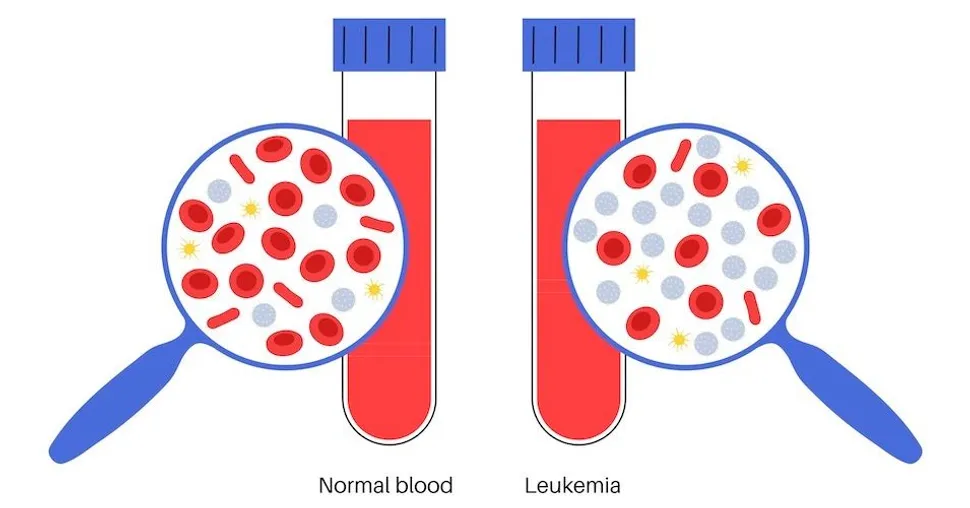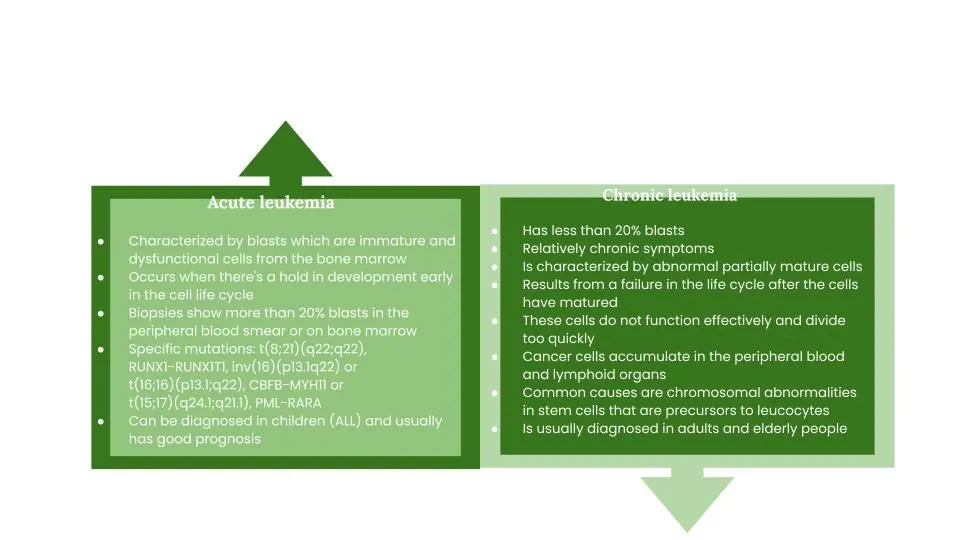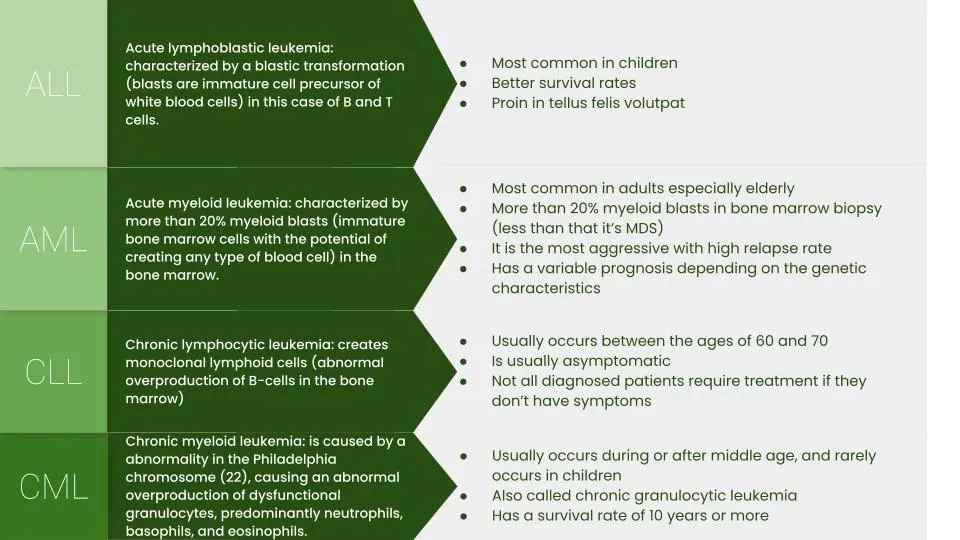What Is The Difference Between Chronic And Acute Leukemia?

Leukemia is the term for a diverse group of blood cancers that arise from the dysfunctional overproduction of blood cells in the bone marrow.
It is classified as acute or chronic based on the time it takes to develop and the type of blood cell it affects.
Treatment depends on a person’s type of leukemia but often involves chemotherapy. Multiple genetic and environmental risk factors are identified in the development of leukemia.
According to the Surveillance, Epidemiology, and End Results (SEER) database, there were 61,090 estimated new cases of leukemia in 2021, accounting for 3.2% of all new cancer cases. This makes leukemia the 10th most common cancer in the United States.
How do I tell the difference between acute and chronic leukemia?
To better understand the differences between acute and chronic leukemia, it’s important to be familiar with the terms “blast” and “monoclonal” because that’s how doctors refer to the characteristics of the cells that can be found in the bone marrow in abnormal quantities:
- Blasts: immature and dysfunctional cells that should normally comprise 1% to 5% of bone marrow cells.
- Monoclonal cells: mature, but dysfunctional cells due to mutations in the bone marrow cells; finding this type of cell is abnormal in a test.
What is Chronic Leukemia?
Chronic leukemia results from a failure in the cell’s life cycle after they have matured. The adult cells can often still function to some extent, which is why some patients don’t present symptoms. There are two types of chronic leukemia: chronic lymphocytic leukemia (CLL) and chronic myeloid leukemia (CML).
What is Acute Leukemia?
Acute leukemia occurs when cell development stops early in the cell’s life cycle, making the cells immature and unpredictable. In acute myeloid leukemia, relapse is common. However, there is a lower chance of leukemia cells returning after chemotherapy in acute lymphocytic leukemia.

What Causes Acute and Chronic Leukemia?
Both conditions are associated with genetic changes that cause the growth of abnormal cells in the bone marrow and have complex genetics.
Some risk factors linked to genetic changes have been identified:
- Congenital syndromes: Klinefelter, Down syndrome, Fanconi anemia, Li-Fraumeni syndrome, among others
- Germline mutations: a change in a body's reproductive cell (egg or sperm) that becomes incorporated into the DNA of every cell in the body of the offspring
- Viral infections: Epstein Barr virus, human T-lymphotropic virus
- Radiation exposure
- Environmental exposure to benzene
- Smoking history
- Previous chemotherapy with alkylating agents and topoisomerase II agents
How Many Types of Leukemia Exist?
There are four types of leukemia: two are acute, and two are chronic.
Each is characterized by different characteristics in the cells that evolve into cancer cells and the age group in which they are commonly diagnosed. Knowing their genetic characteristics can also help researchers develop new ways to treat leukemia to increase the patient’s survival rate and quality of life.

There are rarer types of leukemia that share some characteristics of lymphocytic leukemias and are considered subtypes of chronic or acute lymphocytic leukemia (CLL and ALL).
- Prolymphocytic leukemia (PLL)
- Large granular lymphocyte leukemia (LGL)
- Hairy cell leukemia (HCL)
- Myelodysplastic syndromes (MDS) are conditions related to leukemia that are also rare and commonly evolve into acute myeloid leukemia (AML).
This is why it is very important to continue active research on <disease name> patients so that their progression can be prevented one day. If you want to stay updated with <disease name> treatment advances, join our newsletter!
Source:
- https://www.ncbi.nlm.nih.gov/books/NBK560490/
Leukemia is the term for a diverse group of blood cancers that arise from the dysfunctional overproduction of blood cells in the bone marrow.
It is classified as acute or chronic based on the time it takes to develop and the type of blood cell it affects.
Treatment depends on a person’s type of leukemia but often involves chemotherapy. Multiple genetic and environmental risk factors are identified in the development of leukemia.
According to the Surveillance, Epidemiology, and End Results (SEER) database, there were 61,090 estimated new cases of leukemia in 2021, accounting for 3.2% of all new cancer cases. This makes leukemia the 10th most common cancer in the United States.
How do I tell the difference between acute and chronic leukemia?
To better understand the differences between acute and chronic leukemia, it’s important to be familiar with the terms “blast” and “monoclonal” because that’s how doctors refer to the characteristics of the cells that can be found in the bone marrow in abnormal quantities:
- Blasts: immature and dysfunctional cells that should normally comprise 1% to 5% of bone marrow cells.
- Monoclonal cells: mature, but dysfunctional cells due to mutations in the bone marrow cells; finding this type of cell is abnormal in a test.
What is Chronic Leukemia?
Chronic leukemia results from a failure in the cell’s life cycle after they have matured. The adult cells can often still function to some extent, which is why some patients don’t present symptoms. There are two types of chronic leukemia: chronic lymphocytic leukemia (CLL) and chronic myeloid leukemia (CML).
What is Acute Leukemia?
Acute leukemia occurs when cell development stops early in the cell’s life cycle, making the cells immature and unpredictable. In acute myeloid leukemia, relapse is common. However, there is a lower chance of leukemia cells returning after chemotherapy in acute lymphocytic leukemia.

What Causes Acute and Chronic Leukemia?
Both conditions are associated with genetic changes that cause the growth of abnormal cells in the bone marrow and have complex genetics.
Some risk factors linked to genetic changes have been identified:
- Congenital syndromes: Klinefelter, Down syndrome, Fanconi anemia, Li-Fraumeni syndrome, among others
- Germline mutations: a change in a body's reproductive cell (egg or sperm) that becomes incorporated into the DNA of every cell in the body of the offspring
- Viral infections: Epstein Barr virus, human T-lymphotropic virus
- Radiation exposure
- Environmental exposure to benzene
- Smoking history
- Previous chemotherapy with alkylating agents and topoisomerase II agents
How Many Types of Leukemia Exist?
There are four types of leukemia: two are acute, and two are chronic.
Each is characterized by different characteristics in the cells that evolve into cancer cells and the age group in which they are commonly diagnosed. Knowing their genetic characteristics can also help researchers develop new ways to treat leukemia to increase the patient’s survival rate and quality of life.

There are rarer types of leukemia that share some characteristics of lymphocytic leukemias and are considered subtypes of chronic or acute lymphocytic leukemia (CLL and ALL).
- Prolymphocytic leukemia (PLL)
- Large granular lymphocyte leukemia (LGL)
- Hairy cell leukemia (HCL)
- Myelodysplastic syndromes (MDS) are conditions related to leukemia that are also rare and commonly evolve into acute myeloid leukemia (AML).
This is why it is very important to continue active research on <disease name> patients so that their progression can be prevented one day. If you want to stay updated with <disease name> treatment advances, join our newsletter!
Source:
- https://www.ncbi.nlm.nih.gov/books/NBK560490/

about the author
Jimena Vicencio
Jimena is an International Medical Graduate and a member of the HealthTree Writing team. She has a passion for languages and is currently learning Japanese. In her free time, she loves playing with her cats. Jimena is also pursuing a bachelor's degree in journalism.
Get the Latest Juvenile Myelomonocytic Leukemia Updates, Delivered to You.
By subscribing to the HealthTree newsletter, you'll receive the latest research, treatment updates, and expert insights to help you navigate your health.
Together we care.
Together we cure.
3x Faster.







